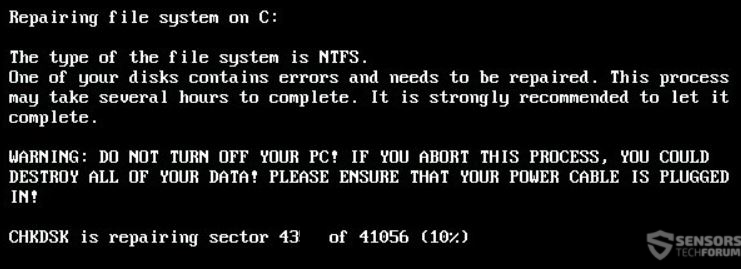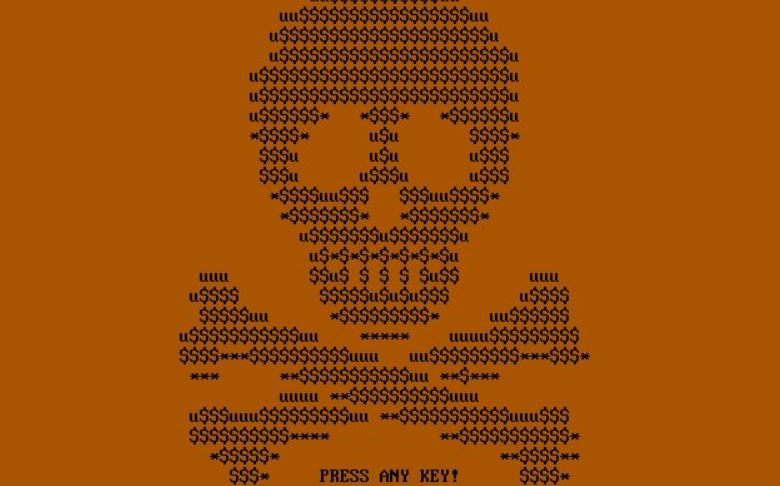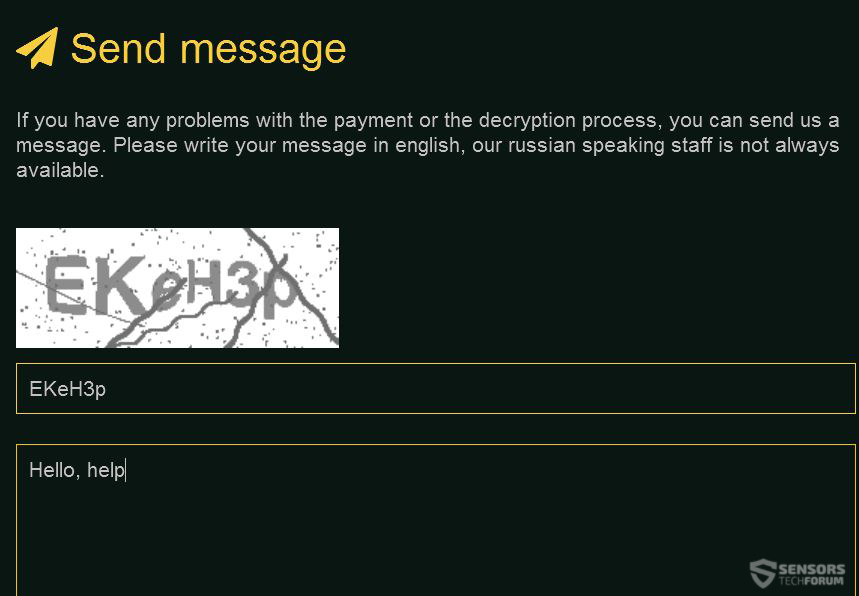This article aims to help you restore encrypted files from your hard drive if it has been infected by Petya GoldenEye Ransomware (other variant is known as Petya Eternal, ExPetr, PetrWrap, NotPetya).
The new ransomware outbreak of GoldenEye ransomware has been reported to target primarily Ukraine, but the malware quickly spread all over the world. This virus aims to encrypt all of the files on a hard drive and the MBR of the drive itself, making it virtually impossible for you to restore your files even if you pay the ransom. Researchers at Kaspersky have detected that the encryption routine of the new Petya/NotPetya virus is designed so that even if a payment is made, the ones behind the virus cannot decrypt your hard drive, even if they wanted to. So if your computer has been infected by this latest GoldenEye variant, you should also not pay the ransom and read this article to learn how to try and get your data back.


Threat Summary
| Name | GoldenEye Ransomware |
| Type | Ransomware, Cryptovirus |
| Short Description | Separate variant of Petya/NotPetya ransomware. Encrypts the MFT (Master File Table) and the files on the infected computer, demanding $300 ransom payoff. |
| Symptoms | A reddish lock-screen on boot, demanding $300. |
| Distribution Method | Spam Emails, Email Attachments, Executable files |
| Detection Tool |
See If Your System Has Been Affected by malware
Download
Malware Removal Tool
|
User Experience | Join Our Forum to Discuss GoldenEye Ransomware. |
| Data Recovery Tool | Windows Data Recovery by Stellar Phoenix Notice! This product scans your drive sectors to recover lost files and it may not recover 100% of the encrypted files, but only few of them, depending on the situation and whether or not you have reformatted your drive. |

The Infection Method of GoldenEye Ransomware
The primary method by which this nasty infection was detected to spread is very sophisticated and very effective. For starters, the cyber-criminals behind the GoldenEye Petya Ransomware have taken advantage of the earlier detected leak of exploits by TheShadowBrokers hacking group, which released multiple exploits for Windows operating systems. One of those, named ETERNALBLUE may have also been used for the GoldenEye Petya virus. However, the actual method of infection is even more interesting – similar to Petya/NotPetya, the virus may get into enterprise computers via an update, quite contrary to what WannaCry ransomware did. Instead of update, the victims receive a malicious executable which is obfuscated to avoid detection by antivirus software. From there, the virus force restarts the computer and begins it’s malicious activity.
Other methods by which GoldenEye ransomware can infect your computer include spam e-mails which aim to get you to click on suspicious e-mail attachments.

GoldenEye Ransomware – Malicious Activity
The first thing done by GoldenEye ransomware is to cause a system restart by ending vital system processes on the infected computer. Then, the virus modifies specific firmware settings on the infected computer to allow it to run on boot. As soon as the victim PC is restarted, the virus begins to pretend that it is actually fixing the file system on your system drive. But if you see the screen below you should immediately switch off your computer and take out the drive to salvage the damage that is done by GoldenEye Petya on your computer.
The virus also encrypts the files on the compromised computers, adding completely random file extensions. The malware then sets the GoldenEye ransom lock screen which prompts to press a key:
If you see this image, this means that the MFT (Master File Table) is encrypted via the Salsa20 mode. The blinking skull is the same as the first Petya, but has a yellow-golden color. If you “PRESS ANY KEY!” GoldenEye leads you to the ransom note of the virus which prompts you to open a Tor-based web page:
The web page has the communism logo along with the name of the virus. It also has a step-by-step instructions on how to pay in BitCoin in order to get the files recovered. The GoldenEye ransomware has a chat, where you can communicate with the cyber-criminals.
When we sum it up, GoldenEye is basically an updated variant of the combined Petya and Mischa ransomware viruses. The cyber-criminals have updated it’s encryption algorithm and have even added captcha identification. For the moment security experts strongly advise victims not to pay any ransom to both Petya GoldenEye and Petna ransomware viruses primarily because they are believed to be developed as cyber-weapons and aim to render the entire drive of the infected computer unusable.

How to Restore Drives Encrypted by GoldenEye Petya
In the even that your computer has become a victim of this virus, at this point there is no direct solution either for GoldenEye Petya or NotPetya ransomware viruses. This is why we have designed a theoretical approach which is in no way guarantee that you will be able to recover your data, but will surely help out a lot in restoring at least some of your files. But first, you need to prepare:
Preparation Phase:
To try decrypting drives by GoldenEye ransomware, you will need the tools to work with first:
- A screwdriver, corresponding to your desktop/laptop.
- A secure computer that is scanned for malware and cleaned and has a proper ransomware protection.
- SATA to USB cable – you can find it very cheap (around $2) in every tech store.
- A secured laptop or desktop PC.
To secure a PC you will need to:
1. Backup all your files in it via a cloud backup software or other methods.
2. Download a relevant malware-protection program to scan the PC.
3. Download a decent data recovery program. Any program will do for you, as long as it supports lost partition recovery.
After having secured the computer, it is recommended to follow the instructions on the video we have made for the new Petya ransomware variants, including GoldenEye:
- Step 1
- Step 2
- Step 3
- Step 4
- Step 5
Step 1: Scan for GoldenEye Ransomware with SpyHunter Anti-Malware Tool



Ransomware Automatic Removal - Video Guide
Step 2: Uninstall GoldenEye Ransomware and related malware from Windows
Here is a method in few easy steps that should be able to uninstall most programs. No matter if you are using Windows 10, 8, 7, Vista or XP, those steps will get the job done. Dragging the program or its folder to the recycle bin can be a very bad decision. If you do that, bits and pieces of the program are left behind, and that can lead to unstable work of your PC, errors with the file type associations and other unpleasant activities. The proper way to get a program off your computer is to Uninstall it. To do that:


 Follow the instructions above and you will successfully delete most unwanted and malicious programs.
Follow the instructions above and you will successfully delete most unwanted and malicious programs.
Step 3: Clean any registries, created by GoldenEye Ransomware on your computer.
The usually targeted registries of Windows machines are the following:
- HKEY_LOCAL_MACHINE\Software\Microsoft\Windows\CurrentVersion\Run
- HKEY_CURRENT_USER\Software\Microsoft\Windows\CurrentVersion\Run
- HKEY_LOCAL_MACHINE\Software\Microsoft\Windows\CurrentVersion\RunOnce
- HKEY_CURRENT_USER\Software\Microsoft\Windows\CurrentVersion\RunOnce
You can access them by opening the Windows registry editor and deleting any values, created by GoldenEye Ransomware there. This can happen by following the steps underneath:


 Tip: To find a virus-created value, you can right-click on it and click "Modify" to see which file it is set to run. If this is the virus file location, remove the value.
Tip: To find a virus-created value, you can right-click on it and click "Modify" to see which file it is set to run. If this is the virus file location, remove the value.
Before starting "Step 4", please boot back into Normal mode, in case you are currently in Safe Mode.
This will enable you to install and use SpyHunter 5 successfully.
Step 4: Boot Your PC In Safe Mode to isolate and remove GoldenEye Ransomware





Step 5: Try to Restore Files Encrypted by GoldenEye Ransomware.
Method 1: Use STOP Decrypter by Emsisoft.
Not all variants of this ransomware can be decrypted for free, but we have added the decryptor used by researchers that is often updated with the variants which become eventually decrypted. You can try and decrypt your files using the instructions below, but if they do not work, then unfortunately your variant of the ransomware virus is not decryptable.
Follow the instructions below to use the Emsisoft decrypter and decrypt your files for free. You can download the Emsisoft decryption tool linked here and then follow the steps provided below:
1 Right-click on the decrypter and click on Run as Administrator as shown below:

2. Agree with the license terms:

3. Click on "Add Folder" and then add the folders where you want files decrypted as shown underneath:

4. Click on "Decrypt" and wait for your files to be decoded.

Note: Credit for the decryptor goes to Emsisoft researchers who have made the breakthrough with this virus.
Method 2: Use data recovery software
Ransomware infections and GoldenEye Ransomware aim to encrypt your files using an encryption algorithm which may be very difficult to decrypt. This is why we have suggested a data recovery method that may help you go around direct decryption and try to restore your files. Bear in mind that this method may not be 100% effective but may also help you a little or a lot in different situations.
Simply click on the link and on the website menus on the top, choose Data Recovery - Data Recovery Wizard for Windows or Mac (depending on your OS), and then download and run the tool.
GoldenEye Ransomware-FAQ
What is GoldenEye Ransomware Ransomware?
GoldenEye Ransomware is a ransomware infection - the malicious software that enters your computer silently and blocks either access to the computer itself or encrypt your files.
Many ransomware viruses use sophisticated encryption algorithms to make your files inaccessible. The goal of ransomware infections is to demand that you pay a ransom payment to get access to your files back.
What Does GoldenEye Ransomware Ransomware Do?
Ransomware in general is a malicious software that is designed to block access to your computer or files until a ransom is paid.
Ransomware viruses can also damage your system, corrupt data and delete files, resulting in the permanent loss of important files.
How Does GoldenEye Ransomware Infect?
Via several ways.GoldenEye Ransomware Ransomware infects computers by being sent via phishing emails, containing virus attachment. This attachment is usually masked as an important document, like an invoice, bank document or even a plane ticket and it looks very convincing to users.
Another way you may become a victim of GoldenEye Ransomware is if you download a fake installer, crack or patch from a low reputation website or if you click on a virus link. Many users report getting a ransomware infection by downloading torrents.
How to Open .GoldenEye Ransomware files?
You can't without a decryptor. At this point, the .GoldenEye Ransomware files are encrypted. You can only open them once they are decrypted using a specific decryption key for the particular algorithm.
What to Do If a Decryptor Does Not Work?
Do not panic, and backup the files. If a decryptor did not decrypt your .GoldenEye Ransomware files successfully, then do not despair, because this virus is still new.
Can I Restore ".GoldenEye Ransomware" Files?
Yes, sometimes files can be restored. We have suggested several file recovery methods that could work if you want to restore .GoldenEye Ransomware files.
These methods are in no way 100% guaranteed that you will be able to get your files back. But if you have a backup, your chances of success are much greater.
How To Get Rid of GoldenEye Ransomware Virus?
The safest way and the most efficient one for the removal of this ransomware infection is the use a professional anti-malware program.
It will scan for and locate GoldenEye Ransomware ransomware and then remove it without causing any additional harm to your important .GoldenEye Ransomware files.
Can I Report Ransomware to Authorities?
In case your computer got infected with a ransomware infection, you can report it to the local Police departments. It can help authorities worldwide track and determine the perpetrators behind the virus that has infected your computer.
Below, we have prepared a list with government websites, where you can file a report in case you are a victim of a cybercrime:
Cyber-security authorities, responsible for handling ransomware attack reports in different regions all over the world:
Germany - Offizielles Portal der deutschen Polizei
United States - IC3 Internet Crime Complaint Centre
United Kingdom - Action Fraud Police
France - Ministère de l'Intérieur
Italy - Polizia Di Stato
Spain - Policía Nacional
Netherlands - Politie
Poland - Policja
Portugal - Polícia Judiciária
Greece - Cyber Crime Unit (Hellenic Police)
India - Mumbai Police - CyberCrime Investigation Cell
Australia - Australian High Tech Crime Center
Reports may be responded to in different timeframes, depending on your local authorities.
Can You Stop Ransomware from Encrypting Your Files?
Yes, you can prevent ransomware. The best way to do this is to ensure your computer system is updated with the latest security patches, use a reputable anti-malware program and firewall, backup your important files frequently, and avoid clicking on malicious links or downloading unknown files.
Can GoldenEye Ransomware Ransomware Steal Your Data?
Yes, in most cases ransomware will steal your information. It is a form of malware that steals data from a user's computer, encrypts it, and then demands a ransom in order to decrypt it.
In many cases, the malware authors or attackers will threaten to delete the data or publish it online unless the ransom is paid.
Can Ransomware Infect WiFi?
Yes, ransomware can infect WiFi networks, as malicious actors can use it to gain control of the network, steal confidential data, and lock out users. If a ransomware attack is successful, it could lead to a loss of service and/or data, and in some cases, financial losses.
Should I Pay Ransomware?
No, you should not pay ransomware extortionists. Paying them only encourages criminals and does not guarantee that the files or data will be restored. The better approach is to have a secure backup of important data and be vigilant about security in the first place.
What Happens If I Don't Pay Ransom?
If you don't pay the ransom, the hackers may still have access to your computer, data, or files and may continue to threaten to expose or delete them, or even use them to commit cybercrimes. In some cases, they may even continue to demand additional ransom payments.
Can a Ransomware Attack Be Detected?
Yes, ransomware can be detected. Anti-malware software and other advanced security tools can detect ransomware and alert the user when it is present on a machine.
It is important to stay up-to-date on the latest security measures and to keep security software updated to ensure ransomware can be detected and prevented.
Do Ransomware Criminals Get Caught?
Yes, ransomware criminals do get caught. Law enforcement agencies, such as the FBI, Interpol and others have been successful in tracking down and prosecuting ransomware criminals in the US and other countries. As ransomware threats continue to increase, so does the enforcement activity.
About the GoldenEye Ransomware Research
The content we publish on SensorsTechForum.com, this GoldenEye Ransomware how-to removal guide included, is the outcome of extensive research, hard work and our team’s devotion to help you remove the specific malware and restore your encrypted files.
How did we conduct the research on this ransomware?
Our research is based on an independent investigation. We are in contact with independent security researchers, and as such, we receive daily updates on the latest malware and ransomware definitions.
Furthermore, the research behind the GoldenEye Ransomware ransomware threat is backed with VirusTotal and the NoMoreRansom project.
To better understand the ransomware threat, please refer to the following articles which provide knowledgeable details.
As a site that has been dedicated to providing free removal instructions for ransomware and malware since 2014, SensorsTechForum’s recommendation is to only pay attention to trustworthy sources.
How to recognize trustworthy sources:
- Always check "About Us" web page.
- Profile of the content creator.
- Make sure that real people are behind the site and not fake names and profiles.
- Verify Facebook, LinkedIn and Twitter personal profiles.









